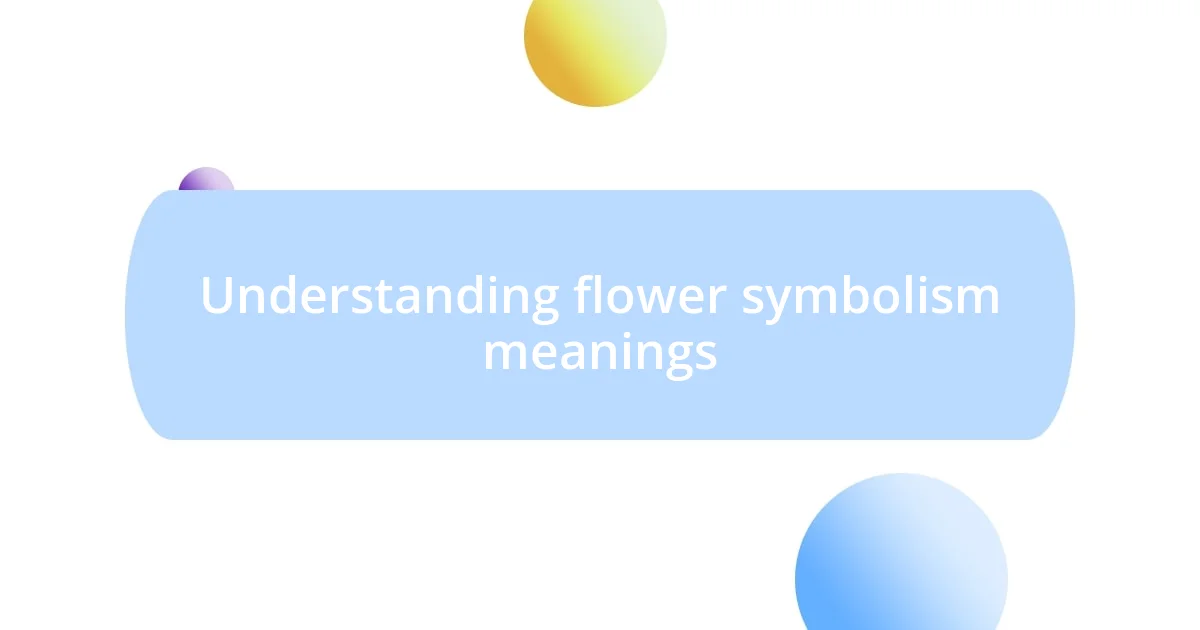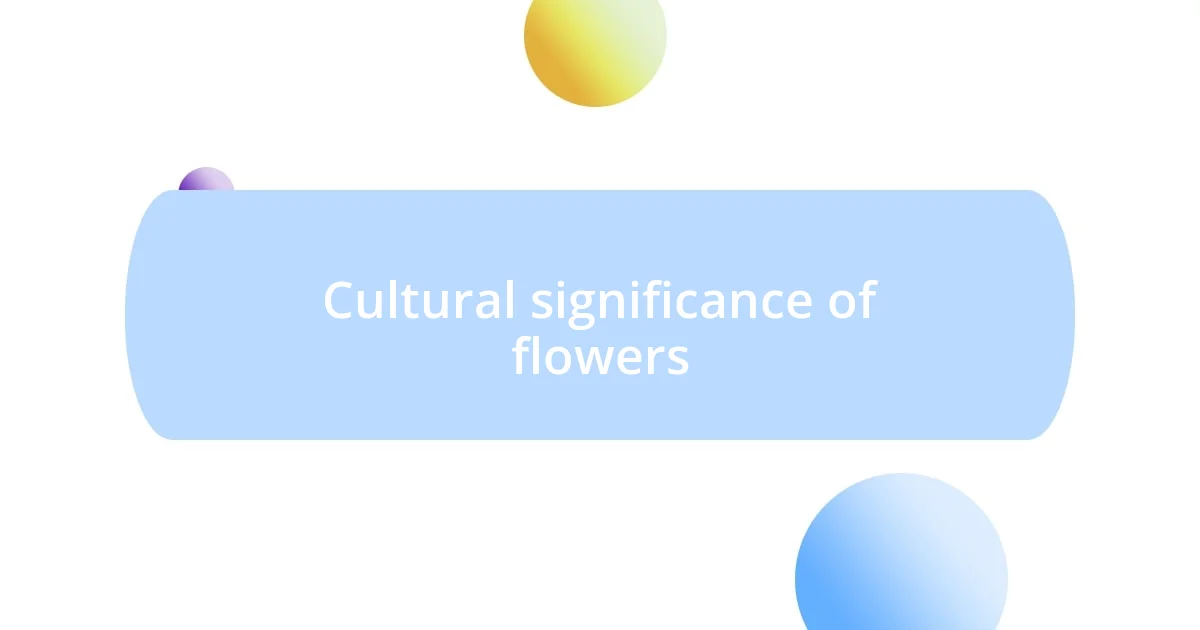Key takeaways:
- Flowers carry profound symbolic meanings that enhance emotional connections and communication in personal relationships.
- Cultural significance of flowers varies widely, with specific blooms representing unique values, traditions, and emotions across different societies.
- Personalizing flower choices based on shared experiences and meanings can deepen connections and elevate special occasions into memorable celebrations.

Understanding flower symbolism meanings
Flower symbolism is a fascinating area that reveals much about emotions and cultural beliefs. For instance, when I first gave my partner a bouquet of red roses, I noticed their immediate smile—the roses conveyed my love and passion without me saying a word. It’s intriguing how colors and types of flowers can evoke such powerful feelings!
I often wonder why certain flowers resonate deeply with specific emotions. Take the sunflower, for example. Its bright, cheerful appearance seems to radiate happiness and warmth. I recall a time when I brought sunflowers to a friend feeling down; their vibrant energy transformed her mood. The symbolism of flowers often touches on shared experiences and feelings, making these gestures incredibly meaningful.
Understanding these meanings can enhance our interactions with others. Have you ever thought about how the flowers you choose for a gift carry messages? Each bloom tells a story, reflecting personal sentiments, celebrations, or condolences. This depth of meaning isn’t just fascinating—it’s a way to connect and communicate more authentically with those around us.

Different flowers and their meanings
Different flowers carry distinct meanings, often rooted in tradition and emotional resonance. For example, I remember the first time I received a bouquet of lilies; their delicate beauty was a reminder of purity and renewal. Similarly, chrysanthemums, which I grew up seeing in my grandmother’s garden, symbolize loyalty and love—no wonder they were often used during family gatherings. It’s fascinating how these flowers can encapsulate personal connections and cultural significance.
Here’s a brief list of some flowers and what they symbolize:
– Roses: Love and passion, with colors conveying different shades of emotion.
– Sunflowers: Adoration and loyalty; they embody warmth and positivity.
– Lilies: Purity, renewal, and beauty—often used in celebrations and memorials.
– Chrysanthemums: Joy and longevity, significant in many cultures for their rich meanings.
– Daisies: Innocence and purity; I always think of them as cheerful reminders of childhood and simplicity.
Understanding these symbolic meanings not only enhances the way we gift flowers but also deepens our appreciation for their presence in our lives.

Cultural significance of flowers
The cultural significance of flowers is deeply rooted in the traditions and beliefs of various societies around the world. For instance, I remember during a visit to Japan, witnessing how cherry blossoms, or “sakura,” play a monumental role in their festivals. People gather under blooming trees to celebrate the fleeting beauty of life, highlighting the connection between nature and transient emotions. It left a lasting impression on me about how flowers can encapsulate not just beauty, but also profound cultural philosophies.
Flowers often serve as symbols of personal milestones in different cultures. For example, in Mexican culture, marigolds are symbolic of Día de los Muertos (Day of the Dead) celebrations, honoring deceased loved ones. I find it incredibly poignant how these vibrant flowers are used to guide souls back home. In my own life, I’ve seen how such practices add layers of meaning to our experiences, reminding us that flowers can bridge the gap between life and death.
An interesting comparison lies in how cultures interpret the same flowers differently. The lotus, revered in many Eastern cultures for its beauty and purity, signifies spiritual enlightenment. Meanwhile, in Western contexts, it can represent rebirth. I’ve often reflected on how these variations reflect differing values and beliefs about life’s journey, making flowers a significant part of cultural identity.
| Flower | Cultural Significance |
|---|---|
| Cherry Blossom (Sakura) | Represents the transient nature of life in Japan; celebrated with festivals. |
| Marigold | Symbolizes remembrance during Día de los Muertos in Mexico; honors deceased loved ones. |
| Lotus | Represents purity and spiritual enlightenment in Eastern cultures; signifies rebirth in Western contexts. |

How to use flower symbolism
When incorporating flower symbolism into your life, consider the emotions and messages you wish to convey. I remember gifting a friend a bouquet of sunflowers during a tough time; their vibrant energy brought a smile to her face and uplifted her spirits. Isn’t it remarkable how the right flower can serve as a heartfelt reminder that someone is thinking of you?
Using flower symbolism can elevate special occasions and everyday gestures alike. For a wedding, roses might be the go-to choice for love, but have you considered adding a few lilies for purity? I recently attended a wedding where the couple intertwined different flower meanings throughout their decor, making every arrangement a beautiful story of their relationship. This thoughtful touch added depth to the celebration and resonated with many guests.
Have you ever thought about what flowers you associate with certain life events? Personally, I’ve found hydrangeas to signify gratitude and understanding, especially after receiving them from a dear friend during a difficult transition. I love how flower symbolism invites us to reflect on our relationships and experiences, making it not just about the beauty of blooms, but also about the stories we share as we navigate life together.

Incorporating flowers into gifts
Incorporating flowers into gifts can add an emotional layer that speaks volumes. I still remember the day I decided to surprise my mother with a bouquet of her favorite daisies for her birthday. As soon as she saw them, her face lit up, and I was reminded how flowers can express feelings that words sometimes can’t capture.
When selecting flowers, it’s essential to consider their meanings. For instance, gifting a friend who’s embarking on a new journey with lavender can symbolize serenity and calm. I once paired a small lavender plant with a handwritten note for a colleague heading off to a new job. The plant not only brightened her desk but also gave her a source of comfort, which made my gift even more meaningful.
Have you thought about how the act of giving flowers can transform the simplest of occasions into something memorable? I recall making a habit of giving my partner wildflowers during our weekend hikes. The spontaneous gesture often sparked joy in our adventures, reminding us that beauty can be found in the everyday moments. It’s these little touches of thoughtfulness that make the gifts infused with blossoms so special.

Flower symbolism in literature
Flower symbolism plays a crucial role in literature, often serving as a powerful tool to convey deeper meanings and emotions. For instance, in Shakespeare’s “Hamlet,” Ophelia’s flowers are imbued with rich symbolism—each bloom representing her fractured psyche and the complexities of love and betrayal. I find it fascinating how a simple flower can speak volumes about a character’s state of mind, creating layers of narrative that draw readers in.
In more contemporary literature, authors like Alice Walker use flowers as symbols of resilience and beauty against adversity. When I read “The Color Purple,” I was moved by how the protagonist’s connection with nature and flowers mirrored her personal growth and healing. Can you remember a book where flowers symbolized something profound to you? I often reflect on how those moments bring a sense of connection to the larger human experience, weaving together themes of hope and endurance through the natural world.
Moreover, the act of giving flowers in literature often embodies more than just a gesture; it reflects societal norms, values, and the intricacies of relationships. I recall a poignant scene in “The Great Gatsby” where Gatsby’s roses symbolize his aspirations and the idealized love he has for Daisy. That moment struck me because it encapsulated the intersection of beauty and tragedy, illustrating how flower symbolism can significantly enhance character development and thematic depth. Isn’t it remarkable to think how flowers, with their fleeting beauty, can carry such emotional weight in storytelling?

Personalizing flower choices with meaning
Choosing flowers that resonate with personal meanings allows us to craft deeper connections with our loved ones. I vividly remember surprising my best friend on her graduation day with a bouquet of sunflowers. Their bright, bold presence not only celebrated her achievement but also embodied the joy and positivity I wanted to share. What better way to symbolize new beginnings than through such a radiant flower?
When I think about personalizing flower choices, I can’t help but recall the time I attended a wedding where each table was adorned with different types of blooms reflecting the stories of the couple. One table featured peonies, which I’ve always associated with prosperity and romance. It amazed me how those specific flowers added layers of thoughtfulness to the wedding’s atmosphere, allowing guests to understand the couple’s journey just through their choices in blossoms.
How do you select flowers for significant moments in your life? I often select flowers based on memories we’ve shared. For instance, I once gifted my sister tulips for her housewarming because they reminded me of our childhood garden. In that moment, the flowers were more than just decorative; they became a bridge to our shared past, making her new space feel more like home. It’s these personal connections that truly elevate our flower choices beyond mere aesthetics.












